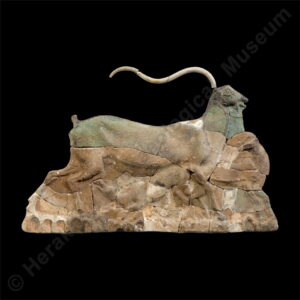
Faience is a vitreous material made of a mixture of pulverised quartz, sandstone or chert, and a sodium carbonate solution. The liquid mix is shaped or placed in moulds for making artefacts, before being fired at a high temperature and solidifying. The outer surface becomes lustrous and either remains whitish or is coloured by adding copper oxide (greenish-blue), manganese (yellow or brown) or cobalt (deep blue). The faience-making technique was known in Egypt as early as the fourth millennium, but soon spread to Syria, Mesopotamia and the Aegean. In Minoan Crete, the first objects of faience appeared shortly before the end of the Early Minoan period (3000-2000 BC). Faience was used to make small vases, jewellery, seals, figurines, plaques and other inlays, and also as a filling material for decorating objects made of other materials.